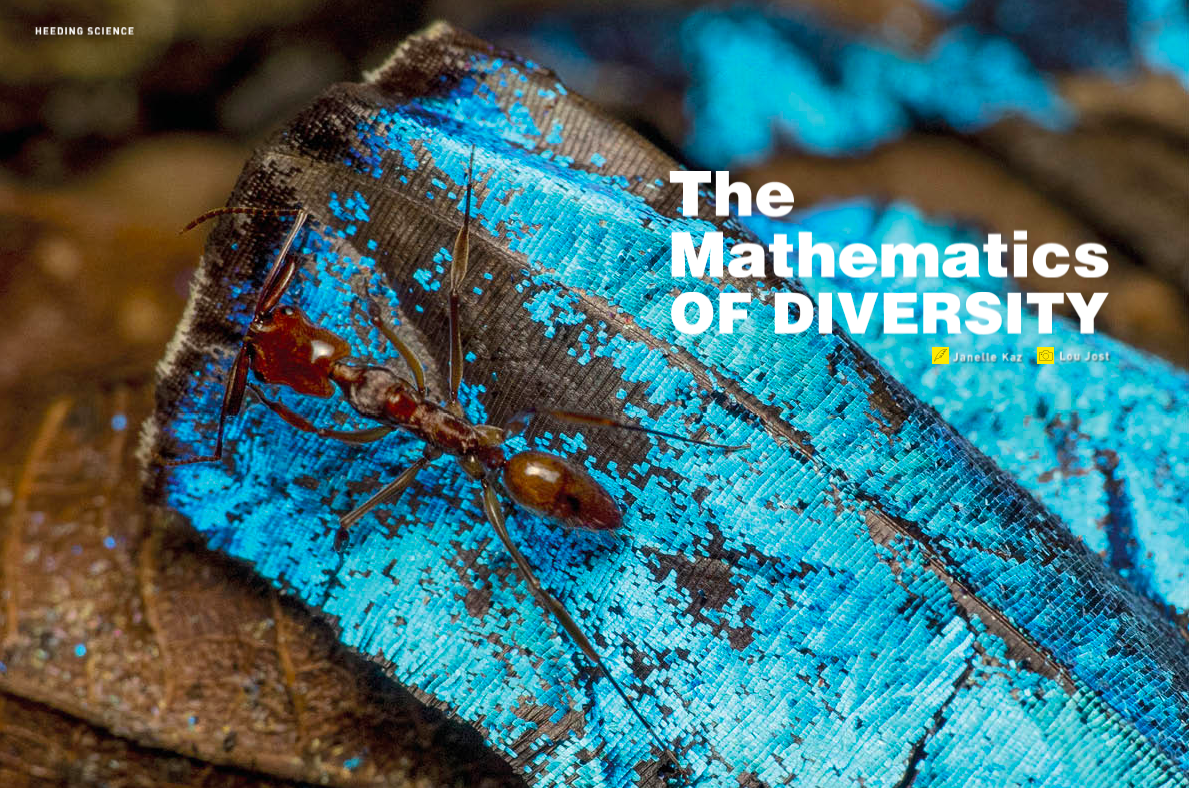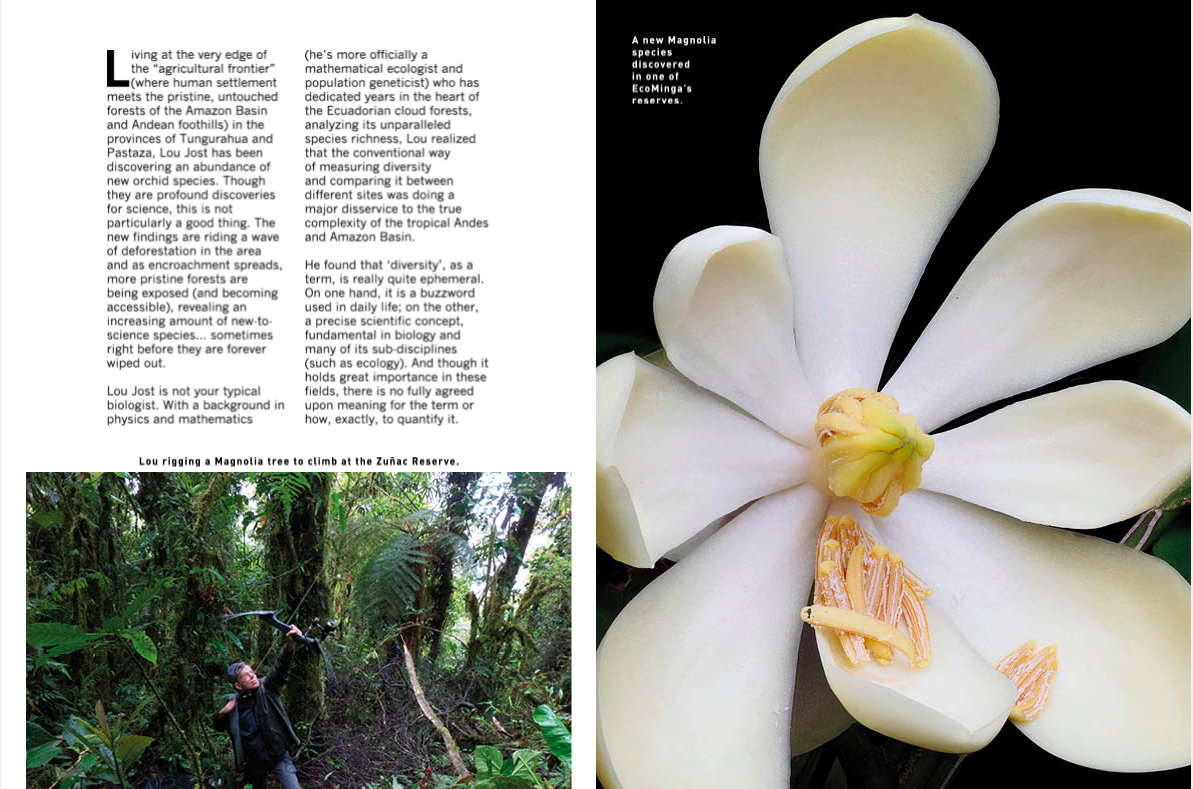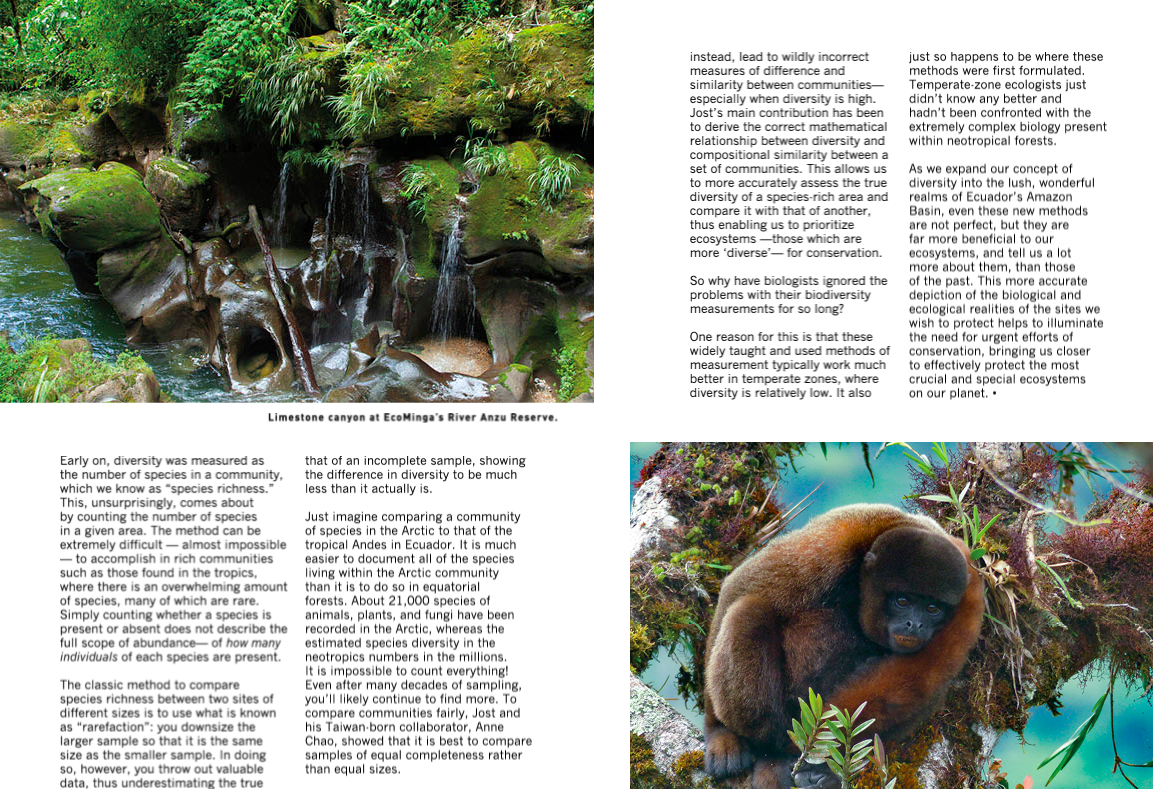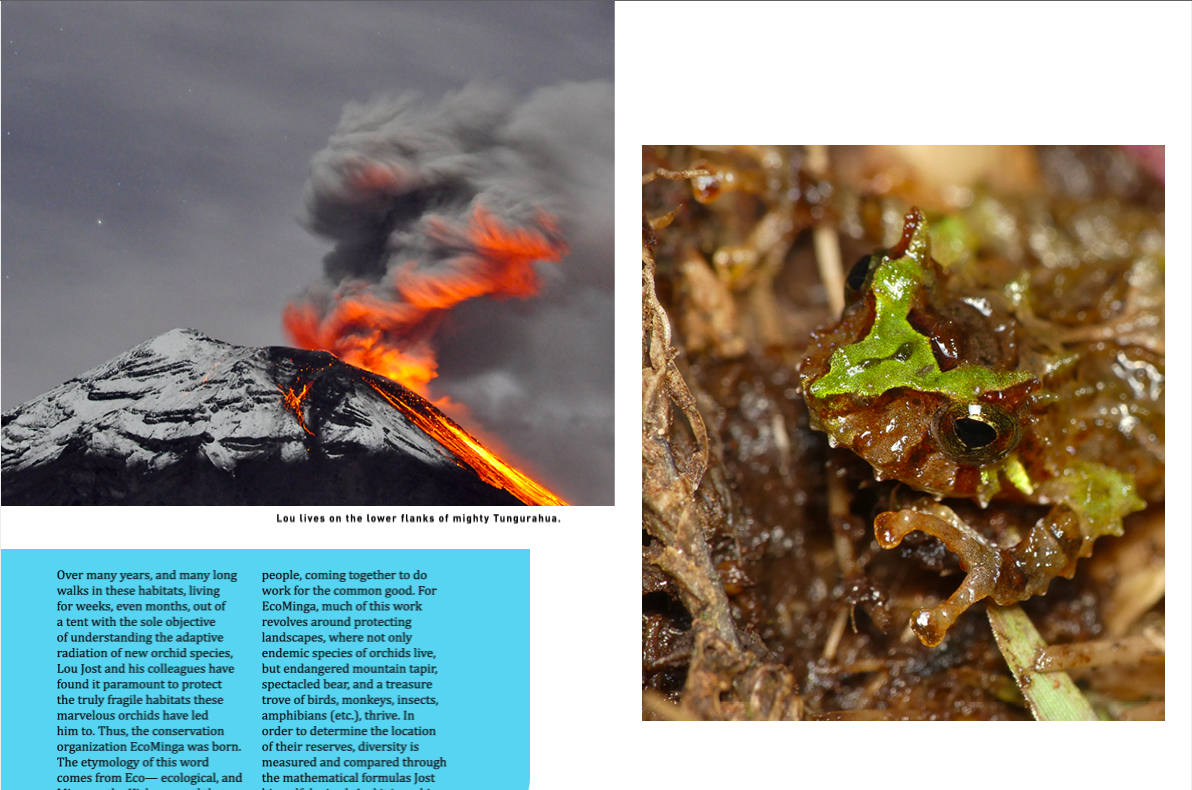Ñan Travel Magazine
The Mathematics of Biodiversity




Many believe that the Amazon Rainforest holds the greatest amount of biodiversity, but this is not so. Within the cloud covered mountains of the northern Andes, there are as many species of plants just in this region as there are in the entire Amazon basin. Every pocket of the Andes is different— with subtle changes in geology, climate, humidity, flora and fauna—which is what makes its diversity so high. Unique species are found from the tops of these harshly rugged mountains down into the valleys, which are different from the adjacent mountain tops and valleys.
You can think of these pockets, with their own microclimates, like islands in the clouds. Each island has an astounding number of species, including one of the most dramatic examples of evolutionary radiation for orchids—or plants, for that matter— on the planet.
Living on the edge of the agricultural frontier, Lou Jost has been discovering an abundance of new species in the Tungurahua and Pastaza provinces. Though they are profound discoveries for science, this is not particularly a good thing, as these new findings are riding a wave of deforestation in the area. As encroachment spreads, most of it for agricultural purposes, more pristine forests are exposed and become accessible, thus revealing an increasing amount of new-to-science species, sometimes right before they are wiped out.
Over many years, and many long walks in these habitats, spending weeks and months living out of a tent with the sole objective of understanding the adaptive radiation of these new orchid species, Lou Jost and others saw the need to protect these fragile habitats. Thus, the conservation organization, EcoMinga was born. The etymology of this word comes from Eco— ecological, and Minga— the Kichwa word that describes lots of people coming together to do work for the common good. Much of the work they do revolves around protecting these landscapes, where not only endemic species of orchids live, but endangered mountain tapir, spectacled bear, and a treasure trove of birds, monkeys, insects, amphibians, etc. In order to determine the location of their reserves, this valuable diversity within an area must be measured and compared.
With a background in physics and mathematics, Jost is not a typical biologist. Seeing the cloud forests of Ecuador and their unparalleled species richness, Jost realized that the conventional way of measuring diversity and comparing it between different sites was doing a major disservice to the true complexity of the many species which live in the tropical Andes.
Through his work, Lou Jost found that diversity as a term is a bit ephemeral, as it is both a buzzword used in daily life and a precise scientific concept, fundamental in biology and many of its subdisciplines, such as ecology. Though it holds great importance in biology, there is no fully agreed upon meaning for this term or how, exactly, to quantify it.
Early on, diversity was measured as the number of species in a community, which we know as “species richness.” This, unsurprisingly, comes about by counting the number of species in a given area. This method can be extremely difficult —almost impossible— to accomplish in rich communities, such as in the tropics, where there is an incredible amount of rare species. Additionally, simply counting whether a species is present or absent does not describe the full scope of abundance— of how many of each species are present.
The classic method to compare species richness between two sites of different sizes is to use what is known as “rarefaction,” to down-size the larger sample so that it is the same size as the smaller sample. In doing so, you throw out valuable data, thus underestimating the ratio of diversity. This often leads to the comparison of a complete sample with that of an incomplete sample, showing the difference in diversity to be much less than it actually is.
Just imagine comparing a community of species within the arctic to that of the tropical Andes in Ecuador. It is much easier to document all of the species living within the Arctic community than it is to do so in equatorial forests. About 21,000 species of animals, plants and fungi have been recorded in the Arctic, whereas the estimated number in the neotropics is in the many millions— and therefore almost impossible to count all of them. Even after many decades of sampling, you’ll likely continue to find more. To compare communities fairly, Jost and his collaborator Anne Chao of Taiwan showed that it is best to compare samples of equal completeness rather than equal sizes.
Additionally, traditional measures of diversity are quite misleading in regards to the true extent of human impact on the environment. Specifically, they always underestimate the magnitude of human impact when biological diversity is high. As you can imagine, quantifying human impact or any kind of disturbance on an ecosystem is extremely important for conservation.
It may come as no surprise that humans have an enormous impact on species and ecosystem diversity, despite the fact that this very biodiversity has brought us extensive economic, medical, and social benefits, in addition to a wealth of natural services, such as clean water, purified air, nourishing soils, etc. Therefore, it is essential that we actively choose to minimize our negative impacts on the environment. Underestimating the extent of our negative impact could therefore have disastrous results for everything that depends on those ecosystem— humans included.
Traditional measurements don’t behave the way biologists expect them to, but instead lead to wildly incorrect measures of difference and similarity between communities— especially when diversity is high. Jost’s main contribution was to derive the correct mathematical relationship between diversity and compositional similarity between a set of communities. This allows us to accurately assess the true diversity of a species-rich area and compare it with that of another, thus enabling us to prioritize ecosystems for conservation.
So why have biologists ignored the problems with their biodiversity measurements for so long?
Biologists, such as ecologists and geneticists, often treat their measurements as mere components for the calculation of a p-value, to reveal some level of statistical significance. However, statistical significance depends at least as much on sample size as on the magnitude of the effect being measured.
Traditional scientific methods include testing against “a null hypothesis,” a type of hypothesis used in statistics that proposes that there is no difference between certain characteristics of a population.
In natural populations, the null hypothesis of zero differentiation between communities is nearly always false— meaning, there is always some amount of difference. If the sample size is large enough, a difference can always be shown to have any desired degree of statistical significance.
Though testing the null hypothesis against a p-value is the common practice in science, and is taught globally in academia, this method does not reveal how much of an effect was observed and therefore is rarely the appropriate model for valid research.
Currently, the method of an always-false null hypothesis and p-value is being taught at universities and graduate schools. Why? Because this is what the scientific community and journal editors use. Why do so many people in the scientific community still use this method? Because that is what they were taught in university and graduate school.
The widely taught and used methods of measurement typically work better in temperate zones, where diversity is lower, which just so happens to be where these methods originate from.
What is needed is a shift in the way ecological sciences are quantified, to break free of this needless cycle, as it does not substitute for real measures of effect size and is rarely the appropriate model for valid research. We should move to methods where questions are designed in terms of estimating meaningful parameters and statistical uncertainties are expressed in confidence intervals, rather than testing an always-false null hypothesis and determining an arbitrary p-value.
